Abstract
UCHT1, a CD3-producing hybridoma, is lysed by cloned human T cells of both CD4 and CD8 phenotypes. The lysis is specific for the CD3 receptor and is mediated by 90% or more of all T cells from blood, without evidence for a subset of CD4 T cells incapable of cytotoxicity. CD4 clones characterized as 'helper' cells by in vitro help for specific antibody production by B cells also lysed CD3 targets. Varicella zoster virus (VZV) super-infected B lymphoblasts were lysed by three of six VZV-specific T-cell clones and 1 Cl-specific T-cell clones lysed 1 Cl hybridoma targets. Resting B cells (from tonsil) coated with CD3 antibody were lysed by CD4 clones. The data suggest that the majority of clonable CD4+ T cells lyse target cells recognized via CD3 or through the antigen receptor.
Full text
PDF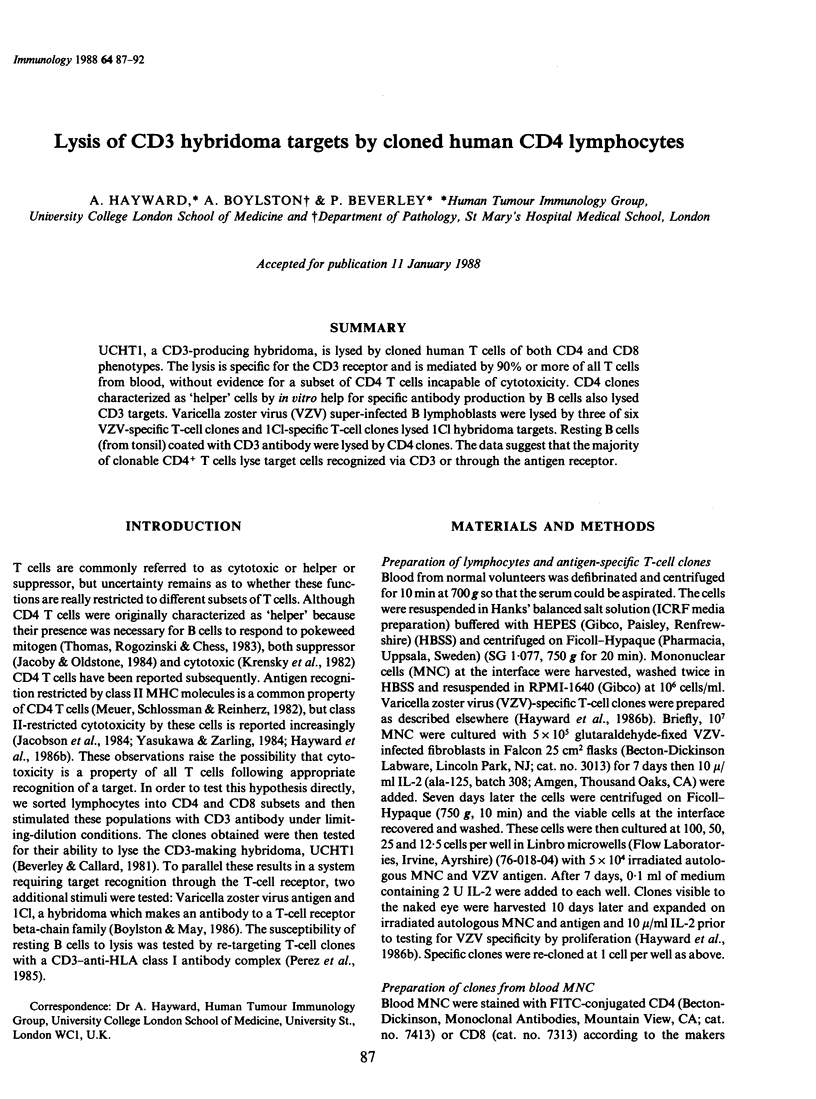
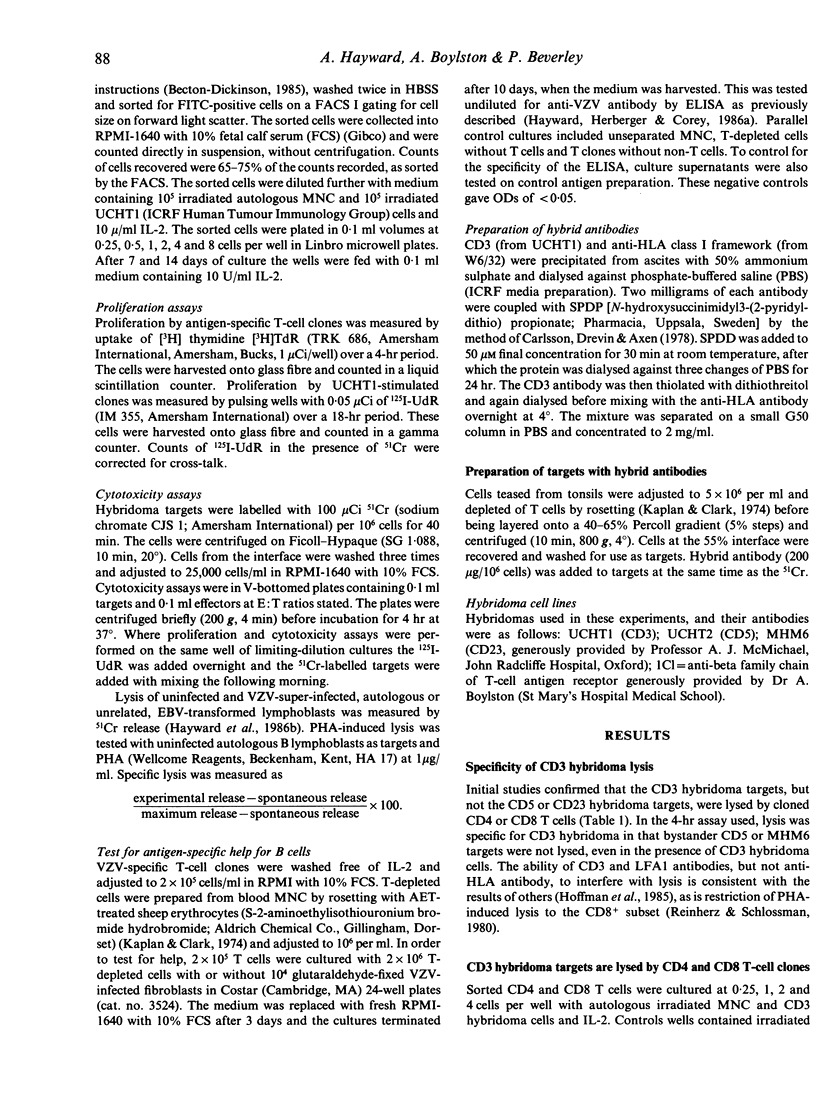
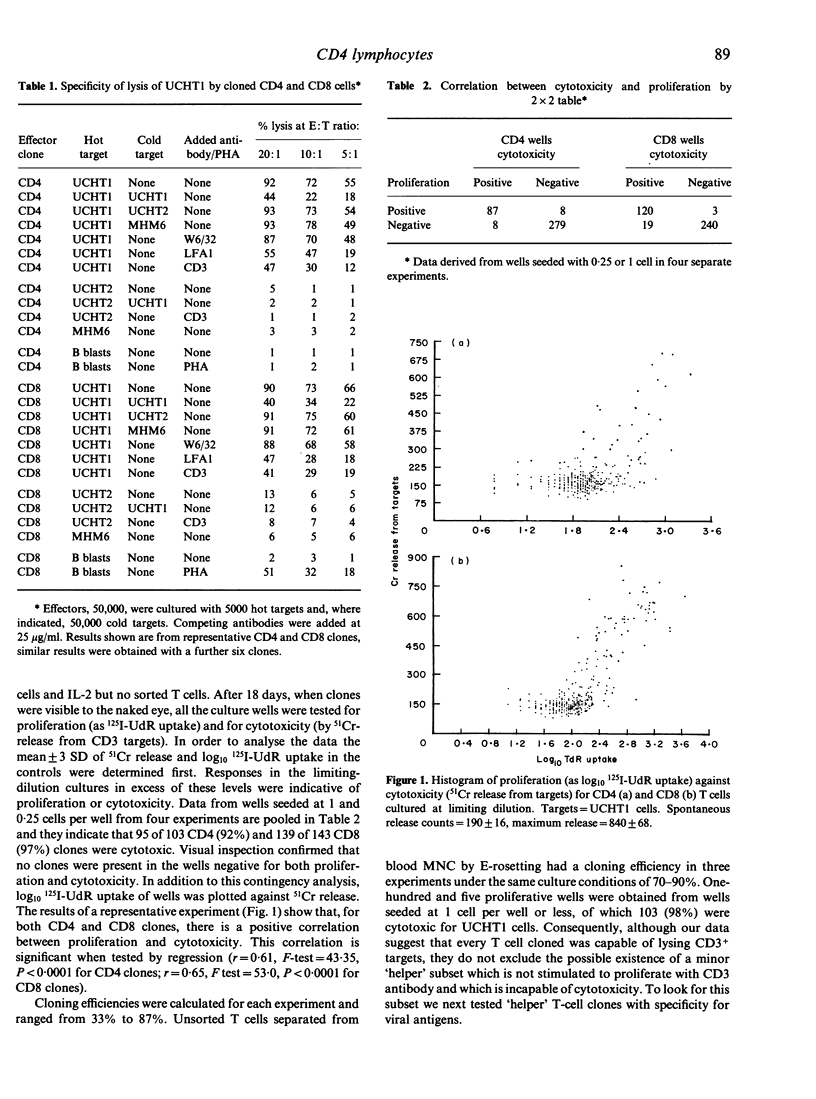
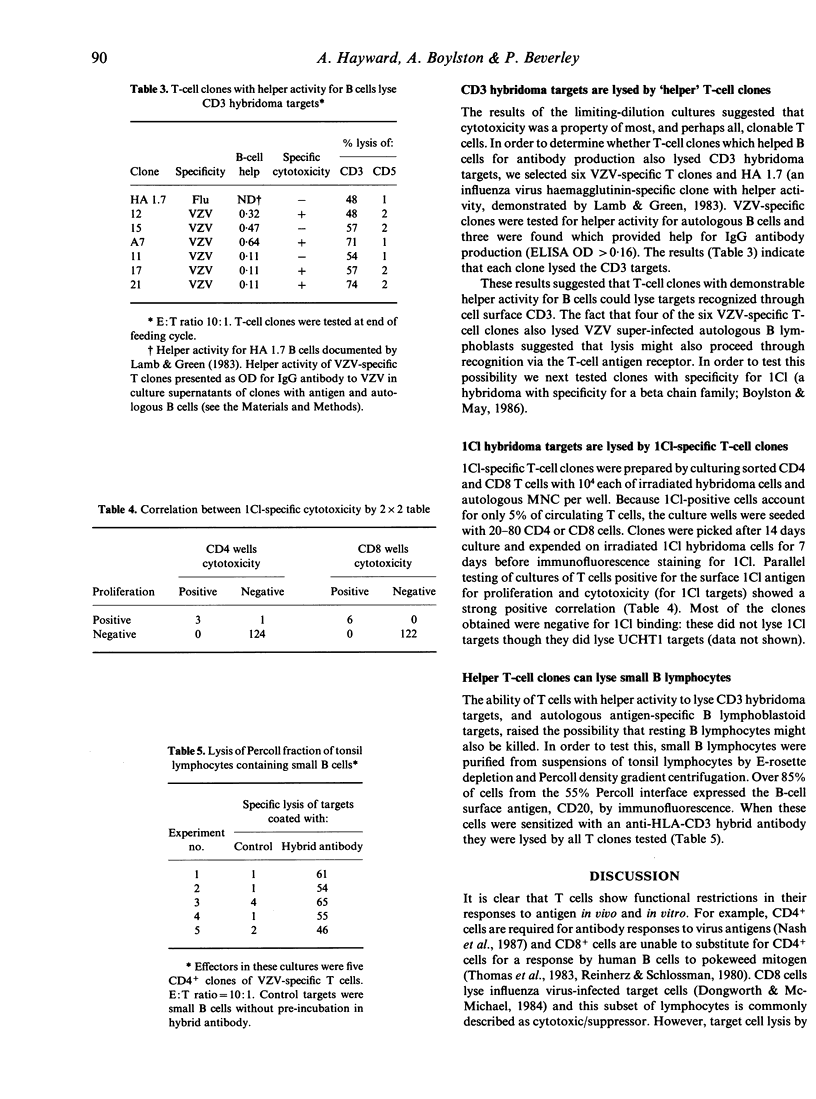
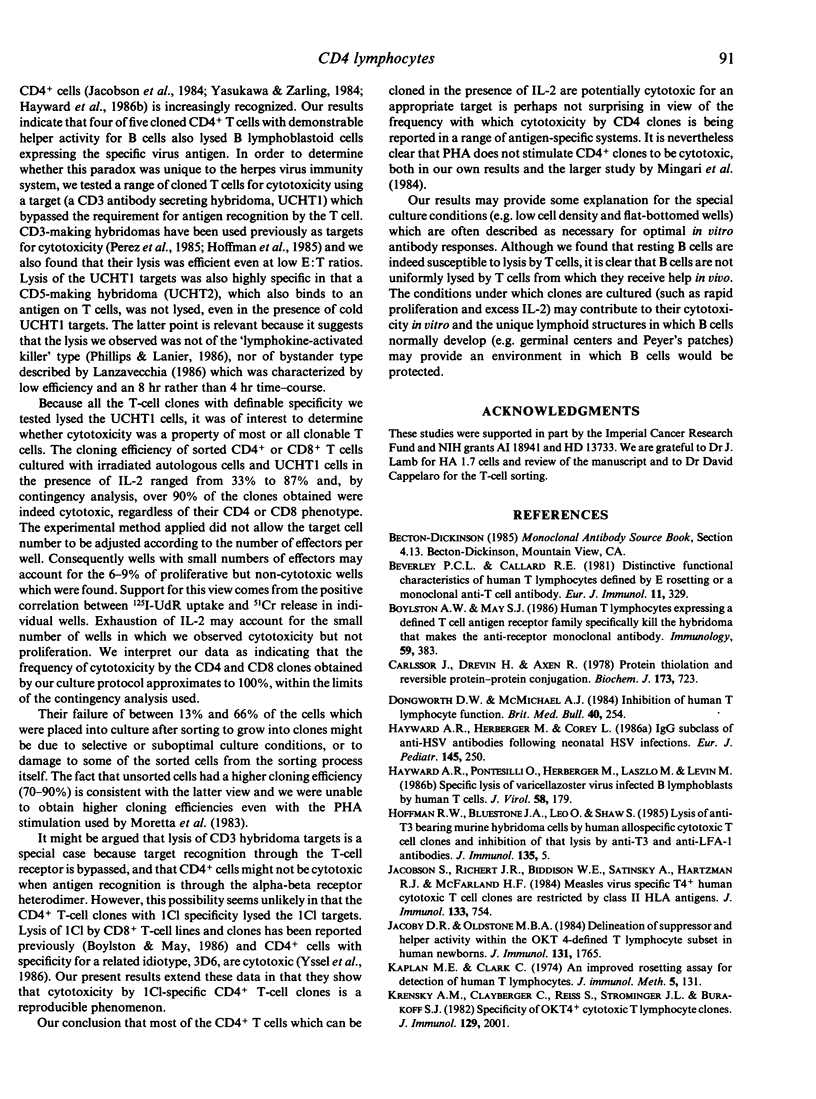
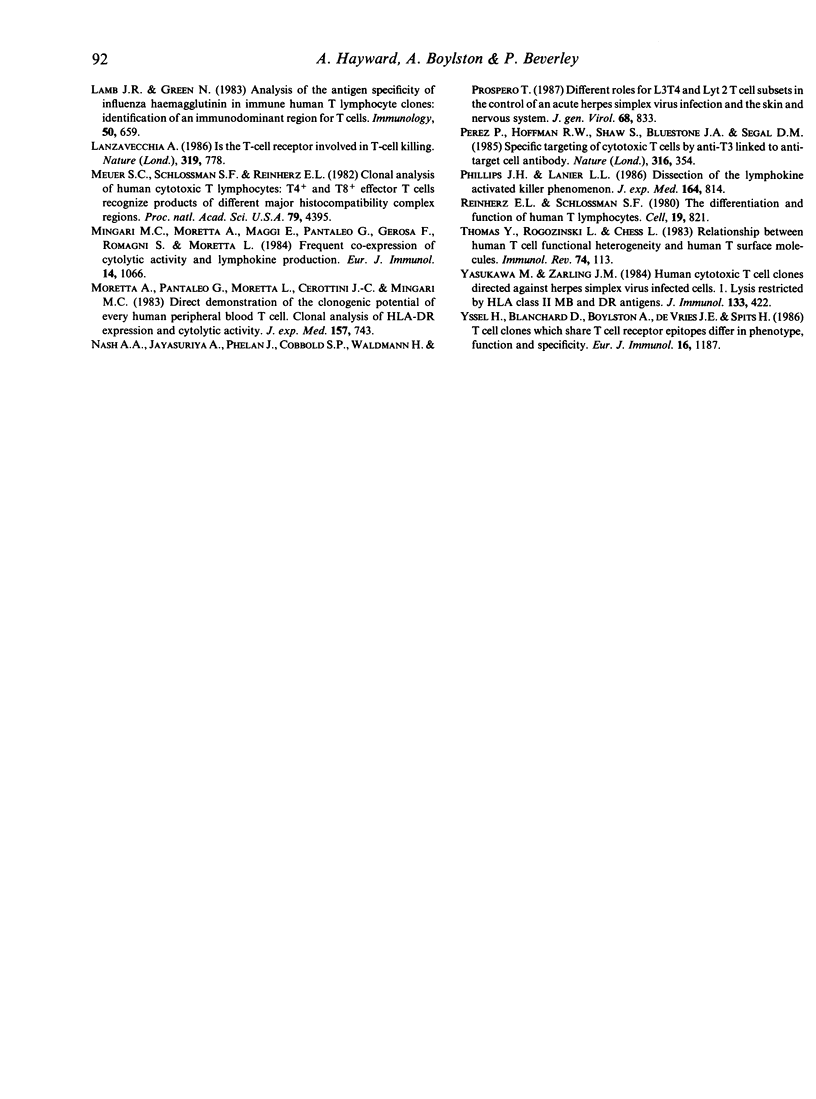
Selected References
These references are in PubMed. This may not be the complete list of references from this article.
- Beverley P. C., Callard R. E. Distinctive functional characteristics of human "T" lymphocytes defined by E rosetting or a monoclonal anti-T cell antibody. Eur J Immunol. 1981 Apr;11(4):329–334. doi: 10.1002/eji.1830110412. [DOI] [PubMed] [Google Scholar]
- Boylston A. W., May S. J. Human T lymphocytes expressing a defined T-cell antigen receptor family specifically kill the hybridoma that makes the anti-receptor monoclonal antibody. Immunology. 1986 Nov;59(3):383–387. [PMC free article] [PubMed] [Google Scholar]
- Carlsson J., Drevin H., Axén R. Protein thiolation and reversible protein-protein conjugation. N-Succinimidyl 3-(2-pyridyldithio)propionate, a new heterobifunctional reagent. Biochem J. 1978 Sep 1;173(3):723–737. doi: 10.1042/bj1730723. [DOI] [PMC free article] [PubMed] [Google Scholar]
- Dongworth D. W., McMichael A. J. Inhibition of human T lymphocyte function with monoclonal antibodies. Br Med Bull. 1984 Jul;40(3):254–261. doi: 10.1093/oxfordjournals.bmb.a071986. [DOI] [PubMed] [Google Scholar]
- Hayward A. R., Pontesilli O., Herberger M., Laszlo M., Levin M. Specific lysis of varicella zoster virus-infected B lymphoblasts by human T cells. J Virol. 1986 Apr;58(1):179–184. doi: 10.1128/jvi.58.1.179-184.1986. [DOI] [PMC free article] [PubMed] [Google Scholar]
- Hayward A., Herberger M., Corey L. IgG subclass of anti-HSV antibodies following neonatal HSV infections. Eur J Pediatr. 1986 Sep;145(4):250–251. doi: 10.1007/BF00439394. [DOI] [PubMed] [Google Scholar]
- Jacobson S., Richert J. R., Biddison W. E., Satinsky A., Hartzman R. J., McFarland H. F. Measles virus-specific T4+ human cytotoxic T cell clones are restricted by class II HLA antigens. J Immunol. 1984 Aug;133(2):754–757. [PubMed] [Google Scholar]
- Jacoby D. R., Oldstone M. B. Delineation of suppressor and helper activity within the OKT4-defined T lymphocyte subset in human newborns. J Immunol. 1983 Oct;131(4):1765–1770. [PubMed] [Google Scholar]
- Kaplan M. E., Clark C. An improved rosetting assay for detection of human T lymphocytes. J Immunol Methods. 1974 Jul;5(2):131–135. doi: 10.1016/0022-1759(74)90003-9. [DOI] [PubMed] [Google Scholar]
- Krensky A. M., Clayberger C., Reiss C. S., Strominger J. L., Burakoff S. J. Specificity of OKT4+ cytotoxic T lymphocyte clones. J Immunol. 1982 Nov;129(5):2001–2003. [PubMed] [Google Scholar]
- Lamb J. R., Green N. Analysis of the antigen specificity of influenza haemagglutinin-immune human T lymphocyte clones: identification of an immunodominant region for T cells. Immunology. 1983 Dec;50(4):659–666. [PMC free article] [PubMed] [Google Scholar]
- Lanzavecchia A. Is the T-cell receptor involved in T-cell killing? 1986 Feb 27-Mar 5Nature. 319(6056):778–780. doi: 10.1038/319778a0. [DOI] [PubMed] [Google Scholar]
- Meuer S. C., Schlossman S. F., Reinherz E. L. Clonal analysis of human cytotoxic T lymphocytes: T4+ and T8+ effector T cells recognize products of different major histocompatibility complex regions. Proc Natl Acad Sci U S A. 1982 Jul;79(14):4395–4399. doi: 10.1073/pnas.79.14.4395. [DOI] [PMC free article] [PubMed] [Google Scholar]
- Mingari M. C., Moretta A., Maggi E., Pantaleo G., Gerosa F., Romagnani S., Moretta L. Frequent coexpression of cytolytic activity and lymphokine production among human T lymphocytes. Production of B cell growth factor and interleukin 2 by T8+ and T4+ cytolytic clones. Eur J Immunol. 1984 Nov;14(11):1066–1069. doi: 10.1002/eji.1830141121. [DOI] [PubMed] [Google Scholar]
- Moretta A., Pantaleo G., Moretta L., Cerottini J. C., Mingari M. C. Direct demonstration of the clonogenic potential of every human peripheral blood T cell. Clonal analysis of HLA-DR expression and cytolytic activity. J Exp Med. 1983 Feb 1;157(2):743–754. doi: 10.1084/jem.157.2.743. [DOI] [PMC free article] [PubMed] [Google Scholar]
- Nash A. A., Jayasuriya A., Phelan J., Cobbold S. P., Waldmann H., Prospero T. Different roles for L3T4+ and Lyt 2+ T cell subsets in the control of an acute herpes simplex virus infection of the skin and nervous system. J Gen Virol. 1987 Mar;68(Pt 3):825–833. doi: 10.1099/0022-1317-68-3-825. [DOI] [PubMed] [Google Scholar]
- Perez P., Hoffman R. W., Shaw S., Bluestone J. A., Segal D. M. Specific targeting of cytotoxic T cells by anti-T3 linked to anti-target cell antibody. Nature. 1985 Jul 25;316(6026):354–356. doi: 10.1038/316354a0. [DOI] [PubMed] [Google Scholar]
- Phillips J. H., Lanier L. L. Dissection of the lymphokine-activated killer phenomenon. Relative contribution of peripheral blood natural killer cells and T lymphocytes to cytolysis. J Exp Med. 1986 Sep 1;164(3):814–825. doi: 10.1084/jem.164.3.814. [DOI] [PMC free article] [PubMed] [Google Scholar]
- Reinherz E. L., Schlossman S. F. The differentiation and function of human T lymphocytes. Cell. 1980 Apr;19(4):821–827. doi: 10.1016/0092-8674(80)90072-0. [DOI] [PubMed] [Google Scholar]
- Thomas Y., Rogozinski L., Chess L. Relationship between human T cell functional heterogeneity and human T cell surface molecules. Immunol Rev. 1983;74:113–128. doi: 10.1111/j.1600-065x.1983.tb01086.x. [DOI] [PubMed] [Google Scholar]
- Yasukawa M., Zarling J. M. Human cytotoxic T cell clones directed against herpes simplex virus-infected cells. I. Lysis restricted by HLA class II MB and DR antigens. J Immunol. 1984 Jul;133(1):422–427. [PubMed] [Google Scholar]
- Yssel H., Blanchard D., Boylston A., De Vries J. E., Spits H. T cell clones which share T cell receptor epitopes differ in phenotype, function and specificity. Eur J Immunol. 1986 Oct;16(10):1187–1193. doi: 10.1002/eji.1830161002. [DOI] [PubMed] [Google Scholar]


